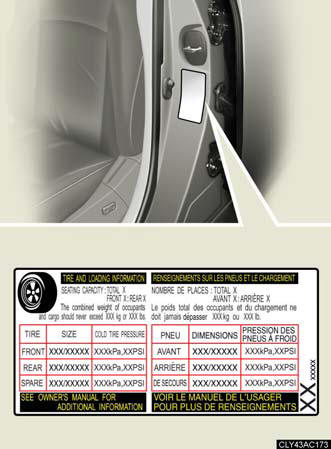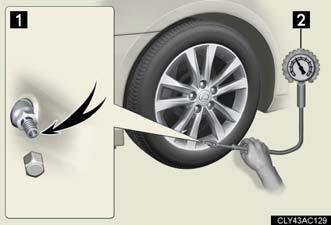Tire inflation pressure
Tire inflation pressure
The recommended cold tire inflation pressure and tire size is displayed on the tire and loading information label.

Inspection and adjustment procedure

1. Tire valve.
2. Tire pressure gauge.
1. Remove the tire valve cap.
2. Press the tip of the tire pressure gauge onto the tire valve.
3. Read the pressure using the graduations of the gauge.
4. If the tire inflation pressure is not within the recommended levels, adjust inflate the tire.
If you add too much air, press the center of the valve to lower.
5. After completing the tire inflation pressure measurement and adjustment, apply soapy water to the valve and check for leakage.
6. Reinstall the tire valve cap.
Tire inflation pressure check interval
You should check tire inflation pressure every two weeks, or at least once a month.
Do not forget to check the spare.
Effects of incorrect tire inflation pressure
Driving with incorrect tire inflation pressure may result in the following: - Reduced fuel efficiency.
- Reduced driving comfort and tire life.
- Reduced safety.
- Damage to the drive train.
If a tire needs frequent refilling, have it checked by your Lexus dealer.
Instructions for checking tire inflation pressure
When checking tire inflation pressure, observe the following: - Check only when the tires are cold.
If your vehicle has been parked for at least 3 hours and has not been driven for
more than 1 mile or 1.5 km, you will get an accurate cold tire inflation
pressure
reading.
- Always use a tire pressure gauge.
The appearance of the tire can be misleading. In addition, tire inflation
pressures
that are even just a few pounds off can degrade ride and handling.
- Do not bleed or reduce tire inflation pressure after driving. It is normal for
the
tire inflation pressure to be higher after driving.
- Never exceed the vehicle capacity weight.
Passengers and luggage weight should be placed so that the vehicle is balanced.
CAUTION:
Proper inflation is critical to save tire performance
Keep your tires properly inflated. Otherwise, the following conditions may occur
and result in an accident causing death or serious injury.
- Excessive wear.
- Uneven wear.
- Poor handling.
- Possibility of blowouts resulting from overheated tires.
- Poor sealing of the tire bead.
- Wheel deformation and/or tire separation.
- A greater possibility of tire damage from road hazards.
NOTICE:
When inspecting and adjusting tire inflation pressure
Be sure to reinstall the tire valve caps.
Without the valve caps, dirt or moisture could get into the valve and cause air
leakage,
which could result in an accident. If the caps have been lost, replace them as
soon as possible.
See also:
Bluetooth® audio system
The Bluetooth® audio system enables you to enjoy music played on a
portable
digital audio player (portable player) from the vehicle speakers via
wireless communication.
This audio system supports ...
Coat hooks
Pull out the hooks to hang coats or other soft items.
CAUTION:
Items that must not be hung on the hook
Do not hang a coat hanger or other hard or sharp object on the hook. If the SRS
curtain shi ...
If the hybrid system will not start
Reasons for the hybrid system not starting vary depending on the
situation.
Check the following and perform the appropriate procedure:
The hybrid system will not start even though the correct star ...
